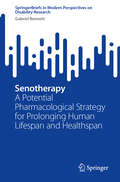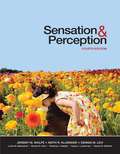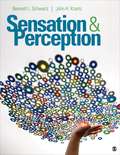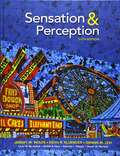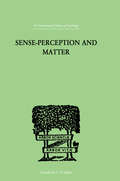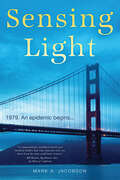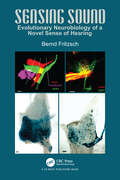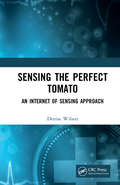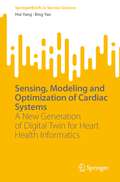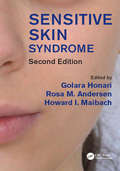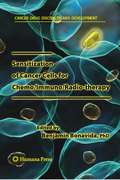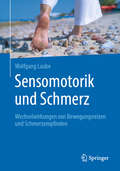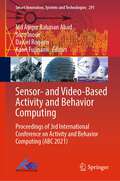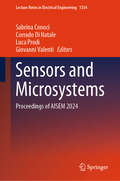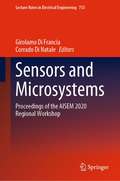- Table View
- List View
Senior Trauma Patients: An Integrated Approach
by Hans-Christoph Pape Heike A. Bischoff-Ferrari Stephen L. Kates Christian HierholzerThis book describes a fully integrated approach to the management of elderly patients who are at risk of or suffer trauma, drawing on up-to-date knowledge from multiple specialties in recognition of the fact that the number and severity of comorbidities in this population requires expertise in many fields. Readers will find comprehensive and detailed coverage of the prevention of complications related to aging, geriatric care concepts, specific treatments in acute care, including fracture stabilization and diagnostic procedures, and the surgical management of different types of fracture and soft tissue trauma. Intensive care management of the geriatric patient is also extensively addressed. Information is provided on diverse aspects of the physiology of ageing, and the coverage is completed by discussion of fracture care service models and specific models of rehabilitation and aftercare designed to prevent further falls and adverse late outcomes. The authors are a group of renowned experts from each of the relevant fields, and the book will be a valuable asset for surgeons, intensivists, geriatricians, gerontologists, and rehabilitation specialists.
Senizid und Altentötung: Ein überfälliger Diskurs (essentials)
by Raimund PoussetRaimund Pousset gibt in diesem essential eine knappe Darstellung des Senizids, die moderne Form der kulturellen Altentötung. Er beleuchtet sowohl die Geschichte als auch die aktuelle Situation einer uralten Methode. Diese seit Jahrtausenden fast überall auf der Welt praktizierte Sitte, alte ‚nutzlose‘ Menschen aktiv zu beseitigen oder sich passiv selbst zu Tode zu befördern, wird heute zunehmend wiederbelebt. Der Senizid ist in unserer modernen, aufgeklärten Gesellschaft ein namenloser und stiller Skandal. Der Autor möchte diesen stillen Tod in den Fokus einer achtsamen Fachöffentlichkeit stellen, denn die Segregation des Alters und die Kostenlawine im Gesundheitswesen lassen vermuten, dass der Senizid weiter an trauriger Bedeutung gewinnen wird.
Senotherapy: A Potential Pharmacological Strategy for Prolonging Human Lifespan and Healthspan (SpringerBriefs in Modern Perspectives on Disability Research)
by Gabriel BennettHistorically, ageing has been regarded as a biological process that is unalterable. Although it is not possible to halt or reverse this process, medical scientists are currently attempting to extend lifespan and healthspan by developing treatments that ensure that the hallmarks of ageing do not resemble someone who is elderly. The accumulation of senescent cells is a hallmark of biological ageing. It is speculated that once the volume of senescent cells exceeds a safe therapeutic threshold the possibility of developing age-associated diseases increases. Senotherapeutic medications, otherwise known as senotherapy, aim to keep the volume of senescent cells below this threshold. These medications either eliminate senescent cells (i.e., senolytic medications) or prevent healthy cells from becoming senescent (i.e., senomorphic medications). While preliminary research shows that senotherapy is a promising strategy for increasing both human lifespan and healthspan, there nevertheless remains many unanswered questions. This book summarises our current research about senescent cell accumulation and age-associated diseases, human trials of senotherapeutic medications, and topics about senotherapy that require more research.
Sensation & Perception (Fourth Edition)
by Jeremy M. Wolfe Keith R. Kluender Dennis M. Levi Linda M. Bartoshuk Rachel S. Herz Roberta Klatzky Susan J. Lederman Daniel M. MerfeldSensation & Perception is written by experts in each of the five senses who have a passion and enthusiasm for conveying the excitement of this field to students. Each of the 15 chapters of this book tells a coherent and interesting story that gives the reader enough background and exposure to enough current research to understand why these topics are interesting and how they might be further investigated and understood.
Sensation And Perception
by Bennett L. Lowell Schwartz John H. Howell KrantzSensation and Perception, by Bennett L. Schwartz and John H. Krantz, is a cutting-edge, easy-to-understand account of the modern sensation and perception field presented from both a cognitive and neurocognitive perspective. The book's rich examples and applications to everyday life emphasize such high-interest topics as music, clinical applications, neuropsychology, and animal perception systems.
Sensation and Perception
by Rachel Herz Roberta Klatzky Linda Bartoshuk Jeremy Wolfe Keith Kluender Dennis Levi Daniel MerfeldSensation & Perception, Sixth Edition, introduces students to their own senses, emphasizing human sensory and perceptual experience and the basic neuroscientific underpinnings of that experience. The authors, specialists in their respective domains, strive to spread their enthusiasm for fundamental questions about the human senses and the impact that answers to those questions can have on medical and societal issues.
Sensation and Perception (Eighth Edition)
by E. Bruce GoldsteinSeeing and reading this sentence may seem like a "no brainer"--but your perception is just a tiny part of what is happening in your brain and body right now (both are much busier than you might think). SENSATION AND PERCEPTION has helped many students like you understand the ties between how we sense the world and how the body interprets these senses. A key strength of this text has always been the ability to illustrate concepts through examples and visuals. Dr. Goldstein walks you through an intriguing journey of the senses, combining clear writing, his extensive classroom experience, and innovative research to create a visual, colorful text. Complemented by nearly 500 illustrations and photographs, this text has also been sharpened to make it more readable than ever, based on feedback from 2,000 student users. The accompanying VIRTUAL LAB media exercises (available on CD-ROM and online) offer a wide array of interactive animations and examples designed to stimulate your understanding of difficult concepts.
Sensation and Perception (Mindtap for Psychology)
by E. Goldstein James BrockmoleE. Bruce Goldstein's SENSATION AND PERCEPTION has helped a myriad of students understand perceptual research and how the results of this research relate to everyday experience. A key strength of this text has always been its ability to illustrate concepts through examples and visuals. Dr. Goldstein and new co-author Dr. James Brockmole take students on an intriguing journey through the senses with both clarity and thoroughness, combining their extensive classroom experience and the most innovative research to create a visual, colorful text.
Sensation in the Pelvic Region
by Jean Jacques WyndaeleThis book covers sensation in all major components of the pelvic region. The small pelvis is containing many different structures and viscera, and sensations elicited there are important for regulating a normal daily life and for warning that something is going wrong. The sensory system is driving in many aspects the motor activity, and precedes and guides the efferent functions. It is surprising that in the last 60 years the ratio between research and publications about sensory versus motor has gradually become less. There has been undoubtedly a rise in the number of publications written on pelvic sensation but in the same time the number of manuscripts on motor function have increased more.It is the hope that this compilation of most data available on sensation will be of interest for the reader, will incite to perform more research so that an important part of pelvic functional diagnosis and treatment modalities will use the whole of the mechanisms available.The book is intended for all interested in pelvic functions and the interactions between the different structures, specialists in urology, gastroenterology, sexuality, pain, pelvic floor function and dysfunction, paediatricians and geriatricians, neurologists, students and those in training . The reader will find interesting and challenging information, and suggestions for further research.
Sense-Perception And Matter: A CRITICAL ANALYSIS OF C D BROAD'S THEORY OF PERCEPTION (International Library Of Psychology Ser.)
by Lean, MartinFirst published in 1999. Routledge is an imprint of Taylor & Francis, an informa company.
Sensing Emotions
by Martijn Krans Martin Ouwerkerk Joyce WesterinkIn the future, products and machines will know how we feel and how to adapt to those feelings. This book analyzes the influence of specific everyday situations and contexts on the emotional state of people and ways this will impact future user experience.
Sensing Light: A Novel
by Mark A. Jacobson&“A POWERFUL WORK OF FICTION THAT AUTHENTICALLY EVOKES THE BAD AND THE GOOD.&”—Eric Goosby, MD, US Global AIDS Coordinator, 2009–13&“A MOVING STORY OF DOCTORS NAVIGATING THE INTERSECTIONS OF SUFFERING, AMBITION AND DISCOVERY.&”—Krista Bremer, My Accidental JihadThis breakout book by Mark A. Jacobson, a leading Bay Area HIV/AIDS physician, follows three people from vastly different backgrounds, who are thrown together by a shared urgency to find out what is killing so many men in the prime of their lives. Kevin, a gay medical resident from working class Boston, has moved to San Francisco in search of acceptance of his sexual identity. Herb, a middle-aged supervising physician at one of the nation&’s toughest hospitals, struggles with his own emotional rigidity. And Gwen, a divorced mother raising a teen daughter, is seeking a sense of self and security while endeavoring to complete her medical training. Mark A. Jacobson, a professor of medicine at the University of California San Francisco and attending physician at San Francisco General Hospital, began his internship in 1981, just days after the CDC first reported a mysterious, fatal disease affecting gay men.
Sensing Sound: Evolutionary Neurobiology of a Novel Sense of Hearing
by Bernd FritzschHearing is a prerequisite for the evolution of language and thus the development of human societies. It is the only major sense whose evolution can be traced back to vertebrates, starting with sarcopterygians. The book explores the evolution of auditory development that has remained largely unexplored in contemporary theories of neurosensory brain evolution, including the telencephalon. It describes how sensory epithelia from the basilar papilla evolved in the ear and connected dedicated cochlear neurons to neuronal centers in the brain, and deals with how sound is converted through sound modulations into reliably decoded messages. The loss of hearing with age is expected to reach 2.6 billion people by 2050. As such, the book explains and reviews hearing loss at the molecular level to the behavioral level, and provides suggestions to manage the loss.
Sensing the Environment: Regulation of Local and Global Homeostasis by the Skin's Neuroendocrine System
by Cezary Skobowiat Radomir M. Slominski Andrzej T. Slominski Blazej Zbytek Michal A. Zmijewski Jeffery D. SteketeeThe skin, the body's largest organ, is strategically located at the interface with the external environment where it detects, integrates and responds to a diverse range of stressors, including solar radiation. It has already been established that the skin is an important peripheral neuroendocrine-immune organ that is closely networked with central regulatory systems. These capabilities contribute to the maintenance of peripheral homeostasis. Specifically, epidermal and dermal cells produce and respond to classical stress neurotransmitters, neuropeptides and hormones, production which is stimulated by ultraviolet radiation (UVR), biological factors (infectious and non-infectious) and other physical and chemical agents. Examples of local biologically active products are cytokines, biogenic amines (catecholamines, histamine, serotonin and N-acetyl-serotonin), melatonin, acetylocholine, neuropeptides including pituitary (proopiomelanocortin-derived ACTH, b-endorphin or MSH peptides, thyroid stimulating hormone) and hypothalamic (corticotropin-releasing factor and related urocortins, thyroid-releasing hormone) hormones, as well as enkephalins and dynorphins, thyroid hormones, steroids (glucocorticoids, mineralocorticoids, sex hormones, 7-δ steroids), secosteroids, opioids and endocannabinoids. The production of these molecules is hierarchical, organized along the algorithms of classical neuroendocrine axes such as the hypothalamic pituitary adrenal axis (HPA), hypothalamic-thyroid axis (HPT), serotoninergic, melatoninergic, catecholaminergic, cholinergic, steroid/secosteroidogenic, opioid and endocannabinoid systems. Disruptions of these axes or of communication between them may lead to skin and/or systemic diseases. These local neuroendocrine networks also serve to limit the effect of noxious environmental agents to preserve local and consequently global homeostasis. Moreover, the skin-derived factors/systems can also activate cutaneous nerve endings to alert the brain to changes in the epidermal or dermal environments, or alternatively to activate other coordinating centers by direct (spinal cord) neurotransmission without brain involvement. Furthermore, rapid and reciprocal communications between epidermal and dermal and adnexal compartments are also mediated by neurotransmission including antidromic modes of conduction. Lastly, skin cells and the skin as an organ coordinate and/or regulate not only peripheral but also global homeostasis.
Sensing the Perfect Tomato: An Internet of Things Approach
by Denise WilsonTomatoes are an important crop for their economic value and nutritional benefits. Optimizing yields for tomato crops requires careful attention to how and when to harvest both in the context of time-to-market and end use. The Internet of Things (IOT), when using distributed and networked sensors, has shown tremendous potential to support precision agriculture, providing a finer resolution, more detailed picture of crops that was not previously possible using conventional crop monitoring techniques. This book marries the potential of the Internet of Sensors to the needs of tomato farming, in ways that are economically fruitful, technologically robust, and environmentally sustainable.
Sensing, Modeling and Optimization of Cardiac Systems: A New Generation of Digital Twin for Heart Health Informatics (SpringerBriefs in Service Science)
by Hui Yang Bing YaoThis book reviews the development of physics-based modeling and sensor-based data fusion for optimizing medical decision making in connection with spatiotemporal cardiovascular disease processes. To improve cardiac care services and patients’ quality of life, it is very important to detect heart diseases early and optimize medical decision making. This book introduces recent research advances in machine learning, physics-based modeling, and simulation optimization to fully exploit medical data and promote the data-driven and simulation-guided diagnosis and treatment of heart disease. Specifically, it focuses on three major topics: computer modeling of cardiovascular systems, physiological signal processing for disease diagnostics and prognostics, and simulation optimization in medical decision making. It provides a comprehensive overview of recent advances in personalized cardiac modeling by integrating physics-based knowledge of the cardiovascular system with machine learning and multi-source medical data. It also discusses the state-of-the-art in electrocardiogram (ECG) signal processing for the identification of disease-altered cardiac dynamics. Lastly, it introduces readers to the early steps of optimal decision making based on the integration of sensor-based learning and simulation optimization in the context of cardiac surgeries. This book will be of interest to researchers and scholars in the fields of biomedical engineering, systems engineering and operations research, as well as professionals working in the medical sciences.
Sensitive Periods of Brain Development and Preventive Interventions (Current Topics in Behavioral Neurosciences #53)
by Susan L. AndersenSensitive periods occur when unique experiences permanently influence brain development either by their presence or absence. This volume covers underlying brain systems and behaviors that are sculpted by the environment in humans and animals in a search for commonalities. The mechanisms involved, the importance of timing in the process, and factors that can change the brain are discussed in this exciting book. Different chapters examine how experience guides the development of cells, circuits, and function using vision, cortical circuits, and cognition as frameworks. Scientific evidence for effective preventative intervention approaches, including diet, exercise, and music, are included to find ways to maximize child and adolescent development. The adverse effects of early brain injury are also included. As sensitive periods are gaining importance in their application in the real-world, novel statistical approaches for human studies are presented and the importance of sensitive periods are covered by examining the juvenile justice system. The book has interdisciplinary appeal and scholars with an interest in brain resiliency or vulnerability will find it of particular interest.
Sensitive Skin Syndrome
by Howard Maibach Golara Honari Rosa AndersenSensitive skin is a widely reported condition where there is subjective cutaneous hyper-reactivity to environmental factors. Progress has been made in many aspects of the background science that will help clinicians in their management of patients presenting with the condition. This new text sums up the advances in thinking on pathophysiology, classification, methods of investigation, and the different susceptibilities of different types of skin.
Sensitization in the Nervous System
by Charles D. BarnesSensitization is a concept of learning and memory that has grown out of experiments on "simple" animals. Interest in sensitization has grown tremendously in the last several years, fueled mainly by evidence of the molecular basis of sensitization in invertebrates on the one hand and the study of cocaine abuse, which produces behavioral sensitization, on the other. Because the rapid advance of information across such a broad range of research areas has made an integrated approach necessary, this volume combines findings on sensitization across the phylogenetic scale.
Sensitization of Cancer Cells for Chemo/Immuno/Radio-therapy
by Benjamin BonavidaThis book reviews novel approaches developed to reverse tumor cell resistance to chemo/immuno/radio-therapy and the use of various sensitizing agents in combination with various cytotoxics. It also introduces several current approaches developed by established investigators that are aimed at overcoming resistance. This is the first volume to compile studies on tumor cell sensitization. It will prove useful for students, scientists, clinicians and pharmaceutical companies.
Sensomotorik und Schmerz: Wechselwirkungen von Bewegungsreizen und Schmerzempfinden
by Wolfgang LaubeDas Buch beschreibt die Physiologie als auch Pathophysiologie der Wechselbeziehung zwischen Bewegung und Schmerz. Dass Bewegung ein präventives und therapeutisches Instrument ist,ergibt sich aus der Struktur und Funktion des sensomotorischen und des nozizeptiven Systems. Beide Systeme haben umfänglich gemeinsame Strukturen, die immer zu stark isoliert betrachtet werden, obwohl sie integrativ miteinander engstens vernetzt sind. Deshalb ist jedes sensomotorische Handlungs- und Bewegungsprogramm sowie gezieltes Training als ursächliche Schmerzprävention und als Therapeutikum anzusehen. Im Grundlagenteil des Buches wird das sensomotorische System mit seiner wichtigen Rolle in der Regulation der Körperhaltung und Bewegung vorgestellt. Im nächsten Abschnitt geht der Autor der Schmerzleistung des Gehirns auf den Grund und erklärt die Zusammenhänge zwischen Sensomotorik und Antinozizeption sowie zwischen Biomechanik und Schmerz. Eine große Sektion versucht die Wirksamkeit einer systematischen präventiven und therapeutischen gesundheitssportlichen Aktivität gegen chronische Schmerzen zu begründen.Das Buch richtet sich an alle Ärzte, die ihre Patienten präventiv beraten und Schmerzpatienten behandeln. Hierzu gehören auch operierende Orthopäden und Traumatologen hinsichtlich des Bedarfs aktiver Programme zur Verbesserung der Funktion in der Nachsorge und Rehabilitation sowie Internisten. Gleichfalls werden Sportmediziner, Physiotherapeuten, Trainer und Übungsleiter angesprochen.
Sensomotorische Einlagen: Grundlagen und Funktionen (essentials)
by Steven Simon Michael Fröhlich Stephan Becker Oliver Ludwig Stefan WoltringIn diesem essential finden Sie anatomische Grundlagen, Wirkidee und Einblicke in die handwerkliche Umsetzung von sensomotorischen Einlagen (SMFO), die zu einem transparenten Verständnis der Funktionsweise verhelfen. Diese Art der orthopädischen Hilfsmittelversorgung birgt viele positive Ansätze, insbesondere bei muskuloskelettalen Beeinträchtigungen und erweitert das Repertoire der individuellen Versorgungsmöglichkeiten.
Sensor- and Video-Based Activity and Behavior Computing: Proceedings of 3rd International Conference on Activity and Behavior Computing (ABC 2021) (Smart Innovation, Systems and Technologies #291)
by Sozo Inoue Daniel Roggen Md Atiqur Rahman Ahad Kaori FujinamiThis book presents the best-selected research papers presented at the 3rd International Conference on Activity and Behavior Computing (ABC 2021), during 20–22 October 2021. The book includes works related to the field of vision- and sensor-based human action or activity and behavior analysis and recognition. It covers human activity recognition (HAR), action understanding, gait analysis, gesture recognition, behavior analysis, emotion, and affective computing, and related areas. The book addresses various challenges and aspects of human activity recognition—both in sensor-based and vision-based domains. It can be considered as an excellent treasury related to the human activity and behavior computing.
Sensors and Microsystems: Proceedings of AISEM 2024 (Lecture Notes in Electrical Engineering #1334)
by Corrado Di Natale Luca Prodi Sabrina Conoci Giovanni ValentiThis book showcases the state of the art in the field of sensors and microsystems, revealing the impressive potential of novel methodologies and technologies. It covers a broad range of aspects, including: bio-, physical and chemical sensors; actuators; micro- and nano-structured materials; mechanisms of interaction and signal transduction; polymers and biomaterials; sensor electronics and instrumentation; analytical microsystems, recognition systems and signal analysis; and sensor networks, as well as manufacturing technologies, environmental, food and biomedical applications. The book gathers a selection of papers presented at the 22nd AISEM National Conference on Sensors and Microsystems, held in Bologna, Italy, in February 2024, which brought together researchers, end users, technology teams and policymakers.
Sensors and Microsystems: Proceedings of the AISEM 2020 Regional Workshop (Lecture Notes in Electrical Engineering #753)
by Corrado Di Natale Girolamo Di FranciaThis book showcases the state of the art in the field of sensors and microsystems, revealing the impressive potential of novel methodologies and technologies. It covers a broad range of aspects, including: bio-, physical and chemical sensors, actuators, micro- and nano-structured materials, mechanisms of interaction and signal transduction, polymers and biomaterials, sensor electronics and instrumentation, analytical microsystems, recognition systems and signal analysis and sensor networks as well as manufacturing technologies, environmental, food, energy and biomedical applications. The book gathers a selection of papers presented at the AISEM Regional Workshop on Sensors and Microsystems, held in Portici (Naples), Italy in February 2020.


